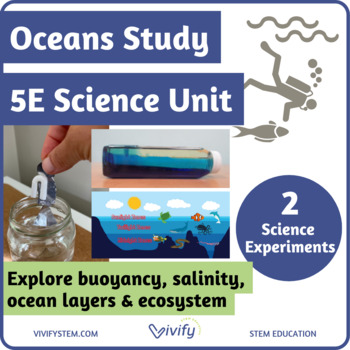Ocean Study: 5E Science Unit (Sink/Float, Salinity, Ocean Layers)
- PDF
What educators are saying
Also included in
- Are you in need of year-round STEM activities? This growing bundle includes our most popular STEM lessons and engineering design challenges for elementary! Activities are adaptable for 1st through 5th grade with guidance provided in the teacher notes. Need help with a STEM Curriculum Map? Grab our FPrice $410.72Original Price $513.40Save $102.68
- Save 20% off individual products with this all-inclusive ocean study STEM unit! Students will explore science concepts through engaging scientific inquiry and apply an engineering mindset to two design challenges, culminating with a final project on researching and building an ocean animal observatoPrice $19.40Original Price $24.25Save $4.85
- Are you in need of year-round STEM activities? This growing bundle includes ALL Vivify K-12 STEM lessons from team challenges, engineering design, semester-long STEM units, research projects, and more! Purchase everything for 20% off individual products! Here is a sample of what is included: Stage 1Price $990.24Original Price $1237.80Save $247.56
Description
5E Ocean Science Unit: Salinity, Buoyancy, and Density!
With 40 pages of teacher slides, step-by-step guide with photos and videos, and editable student handouts - this is everything you need for a complete 5E science unit covering key tops of ocean layers, buoyancy, salinity, and density!
Key Learning Outcomes
- Learn about the STEM Career of an Oceanographer and Jacques Cousteau
- Apply prior knowledge of how items sink or float based on everyday life experiences.
- Predicate if an item will sink or float and justify reasoning.
- Test to see if predictions are accurate.
- Record predictions and results in a scientific process.
- Predict how changing the type of water will change sink or float results. Compare and contrast saltwater to freshwater.
- Light objects have buoyancy and float in water.
- Divers have to add weight belts to their bodies to overcome the buoyancy of their bodies in the water.
- Learn about the 5 oceans, buoyancy, salinity, and density.
- Learn that oceans are salty and salinity and density increase buoyancy.
- Learn the vocabulary of buoyancy, density, and salinity.
Complete 5E Science Unit:
- Engage: Which object will sink or float?
- Explore: Salt Water Density Experiment + Scuba Diver Experiment
- Explain: Connect Experiments to Science Concepts
- Elaborate: Deepen Understanding with Discussion + Ocean Zones in a Bottle STEAM Art Activity
- Evaluate: Think Pair Share + Reflections
5-60 minute Lesson Sequence:
- Session 1: Aluminum Foil activity + STEM Career Connection
- Session 2: Science Experiment #1
- Session 3: Review Sink or Float + Science Experiment #2: Scuba Diver Sink or Float in a Bottle Experiment
- Session 4: Science Concepts + Student Handouts
- Session 5: STEAM Art + Oceans Reflection
Recommended Materials:
- Aluminum foil
- Pencils
- Crayons
- Scissors
- Glue
- Bowl
- Water
- Objects to test: penny, cork, paper clip, small rock, toothpick, spoon
- Salt
- Baking pans
- 2 Liter Bottle (1 per group)
- Funnel
- Modeling clay
- Bendy straws
- Paper clips
Looking for more STEM lessons? Our team of engineers and educators is dedicated to developing low-prep and high-quality STEM activities for any classroom! Click below to learn more:
- Vivify's Scope & Sequence + Standards Alignment
- Vivify's Resource Guide
- Learn about the 3 Stages of STEM
- Vivify STEM Membership
Customer Tips:
• Click the Green ★ to follow our store and get notifications of new products and freebies
• Leave feedback to receive TpT credit for use on future purchases
• Questions? Contact us in the Product Q&A section
♥ Connect With Us ♥
Email us: info@vivifystem.com








